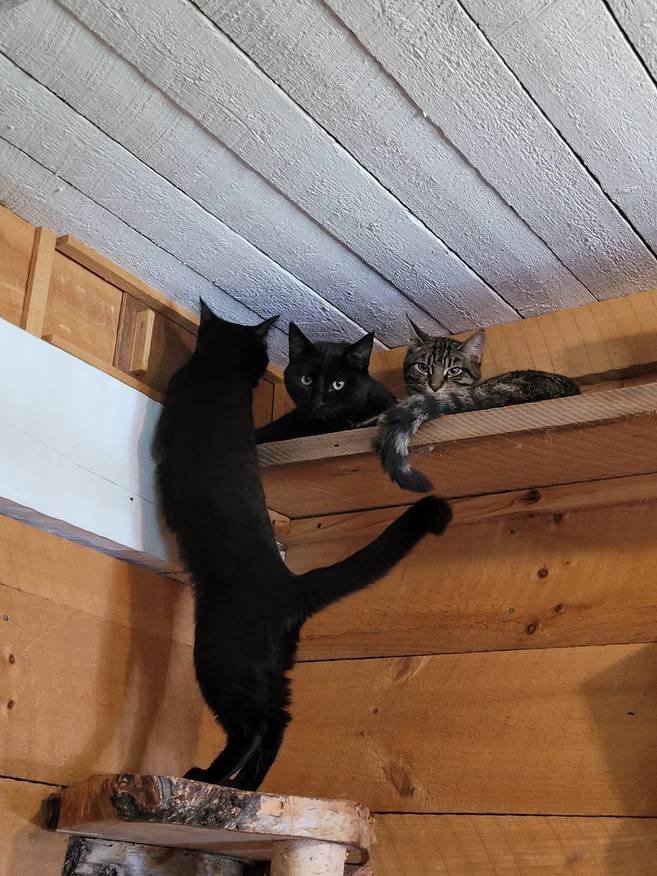But the damaging effects of discrimination don’t stop there… Of this population of lonely people, a certain number seem to have an even harder time than the rest being offered a second chance: pets with black coats.
Whether they are dogs or cats, if they have the misfortune of being black, many of them are likely to be victims of “Black Animal Syndrome”. Although there is still room for research to better understand and document the phenomenon, in the “field”, the critical situation of these furry people is recognized. Less adopted and more euthanized than others, animals with black fur are also considered more aggressive. Several hypotheses are advanced to explain this representation.
Black look on a black background
For some, it would be a matter of the less photogenic side of black animals. At least those with dark eyes. In the age of online adoptions, the photo becomes the first entry point to the eventual bond. However, the dark gaze of the black dog is difficult to capture for anyone who is not a professional photographer. Since the eye is the window to the soul, if we don’t know how to see through its expression, it might be easier to just move on to the next image until we come across a “someone with four paws” that makes us a better first impression. Let’s add that in our western culture the black animal gets a bad press. Black is actually associated with the color of sinister, even evil! It is no coincidence that we associate witches with black cats, crows and other dark spiders. Perhaps this color evokes some atavistic fear, dormant deep in our hunter-gatherer DNA, of the predator lurking in the shadows… Black as the color of the wild!
A domestication
In our fabulous adventure of co-evolution between species, domestication is central. This continuous process, believed to be based first on a stage of mutual adaptation and then on a stage of more deliberate selection, has “brought new species into the world” from native wild species. Thus the rabbit derives its origin from the hare, the sheep from the mouflon and the dog from the wolf. In addition to hypersociability, changes in hormones and the reproductive cycle, and juvenile behavior retained in adulthood, domesticated species also share several specific physical traits grouped under the term domestication syndrome: smaller teeth, jaws, and brain, more rounded craniofacial morphology, drooping ears, curled ears, tail, and a variegated fur. This last feature is the appearance of various patterns of white spots on the coat (and plumage); a kind of little gift that comes as a bonus with domestication! Could it therefore be possible that behind our apparently subjective preferences there is a deeper evolutionary mechanism at work? We would thus be diverted from black animals in favor of those displaying reassuring white patterns? It must be said, the effect is not the same. And if, in addition, as is the case with cats, the dark coat is accompanied by a piercing amber or emerald glance, could not the unsettling influence of the supposed savage be present tenfold? This is because here again research shows us that, at least in dogs, an iris that is darker than light would also be the result of domestication. It seems that despite millennia of good understanding, the prey part of us still starts to tremble if the dog next to us happens to look a little too yellow at us. It is the shadow of the big bad wolf that we think we see dancing in his eyes. Cats, on the other hand, have not experienced the same changes over time. Is this why so many people have such a hard time bearing the cat’s fixed gaze? Note in passing that the expression of their morphological plasticity covers a smaller range of sizes and shapes than in dogs. You will therefore not find the same differences across different breeds of cats as between Great Danes and Chihuahuas.
Queen-La-Ti-Chat and Quentin are (still) looking for their family that we want for life
These are the hypotheses that cross my mind when I look into the golden gaze of Queen-La-Ti-Chat and her brother Quentin, two kittens from the “Q” litter in the sociali-kitten program (here, at the Humanimal Center ) who are always looking for their family that we want for life. How else can we understand that these amazing and friendly little furries have yet to find adopters to open the door to their hearts and their homes? In fact, although they had a more demanding start in life (abandonment at SPCA Saguenay), they did not receive, through our services, the same devoted support from patients, clients, students and lecturers than many others before them (17th litter helped! ) ? Between socialization (people, dogs, ferrets, turtles, pigs, other cats), health care (healthy food, vaccines, worming, neutering, microchipping) and maternal care (clever mix of supportive love and demands) by Marilyn-Monraouuu and Marcya, two exceptional surrogate mothers who teamed up with us to educate the little ones, these little ones got a good dose of human paw anyway. Unfortunately, while their brother Quinoa (grey tabby tabby) has been selected to experience new interspecies adventures, our two black pets with amber eyes are still waiting…
With the hope that by shedding some light on this “fear of the dark” and perhaps like the witches of another time, put discrimination aside to give them the chance to light up our lives as well.
